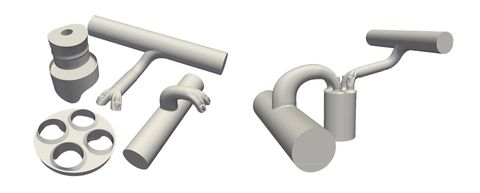
NCC Finland is part of the EuroCC2 project, which establishes national HPC competence centers in different European countries. EuroCC Finland's mission is to support and improve the capabilities of Finnish business users to utilize the opportunities of high- performance computing, data analytics and artificial intelligence. Through EuroCC Finland, companies have access to the computing capacity of the EuroHPC LUMI Supercomputer. EuroCC Finland is operated by CSC – IT Center for Science.
Industrial organisation involved
Wärtsilä Corporation is a global leader in innovative technologies and lifecycle solutions for the marine and energy markets. The company emphasises innovation in sustainable technology and services helping its customers to continuously improve their environmental and economic performance.
Technical/scientific Challenge:
“We deal with very complex and computationally demanding problems which often include mesh motion, chemical reactions, moving particles, and multi-phase flows. We are aiming to improve our cost efficiency and effectiveness in demanding simulations. The scale and complexity of our simulations have to fit within the required timeframes, too,” says Bulut Tekgül, Combustion & CFD Expert at Wärtsila Finland.
Wärtsilä wanted to solve some challenges and enhance their computational capabilities and to explore what expertise the LUMI and CSC have to offer. “In our collaboration with CSC, we aimed at evaluating how LUMI’s resources could help us to perform high-fidelity simulations more efficiently and cost-effectively,” explains Bulut Tekgül.
The test runs also serve Wärtsilä’s ambitions of becoming carbon neutral by 2030.
Solution:
The Wärtsilä’s Thermofluids & Simulations team uses OpenFOAM, an open-source software for CFD simulations. OpenFOAM can be used to simulate internal combustion (IC) engines including piston and valve motion – a functionality that Wärtsilä Finland has developed in collaboration with CFD-Direct. “Our partnership with CFD Direct has been key to unlocking the full potential of OpenFOAM. Combined with LUMI’s computational power, we can effectively tackle large-scale simulations.” The company was really positively surprised by the results. The improved efficiency was clearly visible in their test runs.: "We were able to run our simulations much faster, meeting tight project deadlines and accelerating our R&D processes,"
“We also assessed the cost-efficiency of our in-house infrastructure compared to the LUMI and CSC’s services. We compared the costs, scalability, and performance benefits of each approach, which provided us with a clear understanding of the potential advantages of using HPC. CSC’s responsive service desk ensured that any technical challenges were addressed promptly, minimizing downtime and enhancing overall productivity”, Tekgül concluded.

Business impact: Maximizing simulations, minimizing energy consumption and costs
“By leveraging advanced CFD techniques, we analyse complex fluid dynamics, combustion processes, and thermal interactions to optimize performance, efficiency, and sustainability. Our work plays a crucial role in driving Wärtsilä’s mission to decarbonize marine and energy industries, ensuring innovative and environmentally friendly solutions for a cleaner future. Our focus is towards ramping up our industrial R&D computations in LUMI with the applications already identified. Obviously, our goal is to maximize the use of simulations and minimize carbon intensive energy consumption and costs. If we are successful, we should be able to leverage the use of any capacity offered to us,” Tekgül says.
Benefits:
Improved efficiency in simulations
Accelerated R&D processes
Reduced energy consumption, sustainability
Reduced costs
Success story # Highlights:
Keywords RDI, simulation, sustainability, moving particles, cost efficiency
Technology HPC, CFD (Computational Fluid Dynamics)
Industry Sector Manufacturing & engineering, Energy and Maritime